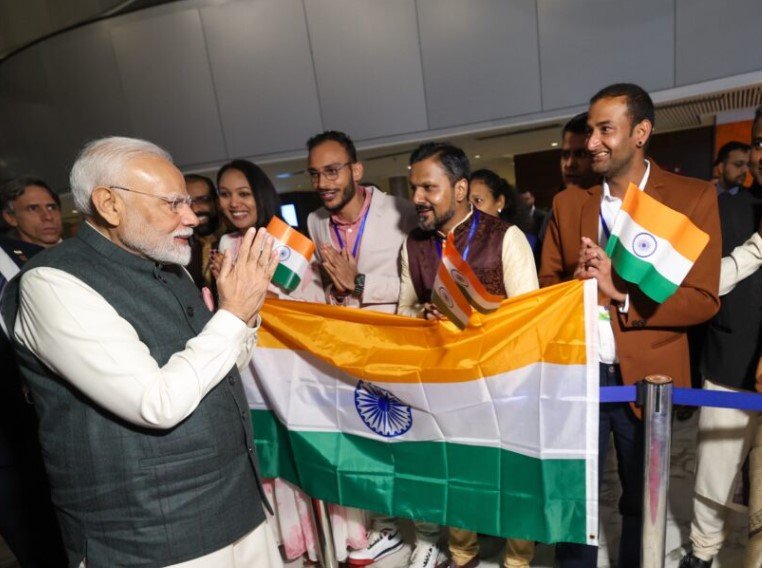Grand Collar of the National Order of the Southern Cross awarded to Indian Prime Minister as both nations eye stronger strategic partnership
Prime Minister Narendra Modi was awarded Brazil’s highest civilian honor on Tuesday during his official visit to Brasilia. The Grand Collar of the National Order of the Southern Cross was presented by President Luiz Inácio Lula da Silva, marking a milestone moment in India-Brazil relations.
The symbolic gesture was not just about protocol. It carried emotional weight and political meaning—for both leaders, and both nations.
A deeply personal moment for Modi
For Modi, it wasn’t just a medal or an official handshake. The award ceremony felt deeply personal. “A moment of immense pride and emotion,” he called it.
Standing beside President Lula after their talks, Modi spoke from the heart. “This isn’t just my honor—it belongs to every Indian,” he said. That line hit home for many watching back in India, where his supporters celebrated the recognition as a validation of India’s growing global profile.
He later echoed the sentiment on social media, writing on X (formerly Twitter):
“This illustrates the strong affection the people of Brazil have for the people of India. May our friendship scale even newer heights.”
That blend of diplomacy and warmth is classic Modi. It’s what’s kept his foreign visits charged with both ceremony and sentiment.

Why this award matters—historically and politically
Brazil doesn’t hand out the Grand Collar of the National Order of the Southern Cross lightly. Reserved for foreign heads of state, it’s a title steeped in symbolism.
Historically, it’s Brazil’s way of recognizing global partners who, in their eyes, stand shoulder to shoulder with the country—not just economically, but ideologically.
Past recipients have included presidents, monarchs, and key political allies. So Modi’s inclusion puts him in elite international company.
It also comes at a critical moment, as India and Brazil try to reposition themselves as Global South leaders with a louder voice in world affairs—from trade rules to climate goals to UN reform.
Lula and Modi: Not just leaders, but architects of strategy
There’s genuine chemistry between the two.
Modi went out of his way to praise Lula during his remarks. He called him “the architect of the India-Brazil Strategic Partnership,” tracing the roots of their current ties to Lula’s earlier tenure.
That wasn’t flattery—it was recognition. Lula and Modi have both used their second stints in office to reenergize relationships neglected in previous years.
What makes it interesting is how both leaders see eye-to-eye on the larger game:
-
Reforming global financial institutions like the IMF and World Bank
-
Amplifying the voice of the Global South at the G20 and BRICS
-
Balancing ties with the U.S. and China without being cornered
For Modi, Lula isn’t just a bilateral partner. He’s a fellow heavyweight in the shifting global order.
What’s in it for both nations?
Bilateral relations between India and Brazil haven’t always been headline material. But that’s changing.
From defense to digital tech to agriculture, both sides see new room to cooperate.
India imports Brazilian crude and soy, while Brazil looks to India for pharma supplies and IT expertise. But beyond trade, the real play is global influence.
This week’s talks reportedly touched on:
-
Deepening military-to-military ties through joint exercises
-
Coordinated stances at the United Nations and WTO
-
Greater investment flows through cross-border infrastructure funds
There’s also a push for more people-to-people interaction—student exchange programs, tourism boosts, and cultural collaborations.
One Brazilian official joked, “We might have more Bollywood fans here than football fans soon.”
That might be an exaggeration. But it shows how diplomacy is becoming pop culture too.
Quick snapshot: The India–Brazil strategic snapshot
Here’s a quick view of how the relationship stacks up:
| Area | Current Engagement | Future Goals |
|---|---|---|
| Trade | ~$12 billion annually | Targeting $25 billion by 2030 |
| Defense | Basic cooperation | Joint exercises and tech sharing |
| Energy | Crude imports from Brazil | Biofuel and renewables collaboration |
| Multilateral Ties | BRICS, G20 | Push for UNSC permanent seats |
| Education | Limited exchange | Scholarships, research partnerships |
Modi’s message: India’s rise is global, not just regional
Modi has always pitched India’s ambitions in global terms—not just as a regional power, but as a responsible player on the world stage.
This award plays into that narrative. It sends a message to other Latin American countries too, where India is looking to build trade bridges and investment routes.
In the words of one Indian diplomat, “This isn’t about one country giving an award. This is about rebalancing friendships in a multipolar world.”
And it seems both leaders know the stakes.
What comes next?
While the ceremony grabbed headlines, the real work begins behind the scenes.
There are reports that Brazil and India are in early talks on co-developing AI tools for climate adaptation in agriculture—something both countries desperately need.
Also expected: closer cooperation on pharma manufacturing, especially in light of Latin America’s post-COVID healthcare needs.
At least one joint working group will be set up before the end of 2025.
And for Modi, this is one more notch in his foreign policy belt—another moment that feeds his political capital back home, where global recognition plays well with voters.
But beyond all the optics, maybe the biggest takeaway is this: two giant democracies, on two continents, figuring out how to stand taller—together.
